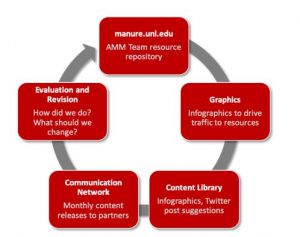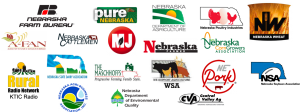The University of Nebraska – Lincoln (UNL) Animal Manure Management (AMM) Team has supported the environmental stewardship goals of Nebraska’s livestock and crop producers for many years using multiple traditional delivery methods, but recently recognized the need to more actively engage with clientele through content marketing activities. A current programming effort by the AMM Team to increase efficient manure utilization on cropland in the vicinity of intensive livestock production is the foundation for an innovative social media campaign.
What did we do?

While traditional extension outputs remain valuable for supporting the needs of clientele who actively seek out information on a topic, “content marketing” is a strategic tactic by which information is shared to not only attract and retain an audience, but to drive impactful action. Social media platforms are popular tools for delivery of current, research-based information to clientele; a key barrier to effectively using social media for content marketing by the project directors has been time. For instance, using Twitter efficiently requires regular attention to deliver messages frequently enough to remain relevant and to do so at times when user activity characteristics demonstrate the greatest opportunity for posts to be viewed and disseminated. Because this proved to be a challenge, a content marketing plan (Figure 1) was initiated using “waste to worth” as the topic of focus.
Three major components were identified as being critical to the success of the project (Figure 2): design of high-quality graphics that are tied to online content and resources and are suitable for use on Twitter, Facebook, or other social media platforms; development of a content library containing packaged content (graphic + suggested text for social media posts) that is easy to navigate and available for partners to access and utilize; and development of a communication network capable of reaching a broad audience.
Graphics

An undergraduate Agricultural Leadership, Education and Communication (ALEC) student was recruited to support graphical content development using three basic guidelines: 1) Eye-catching but simple designs; 2) Associated with existing content hosted online; and 3) Accurate information illustrated Canva.com was utilized by team members to design, review and edit social media content (Figure 3).
Content Library
Completed graphics are downloaded from Canva as portable network graphics (*.png) and saved to Box folders, by topic, using a descriptive title. When posting to social media, hashtags, mentions and links to other content help (a) reach users who are following a specific topic (e.g. #manure), (b) recognize someone related to the post (e.g. @TheManureLady) and (c) direct users to more content related to the graphic (e.g. URL to online article). For our content library, each graphic is accompanied by a file containing recommended text (Figure 4) that can be copied and pasted into Twitter or Facebook.


Communication Network

Disseminating our messages through outlets outside the University was identified as a critical aspect of achieving the widespread message delivery that was desired. As such, agricultural partners throughout Nebraska were asked to help “spread the word about spreading manure” by utilizing our content in their social media outputs, electronic newsletters, printed publications, etc. Partners in this project include nearly 30 livestock and crop commodity organizations, media outlets, agricultural business organizations, and state agencies in Nebraska (Figure 5).
The effort to distribute content through the established communication network was launched in September 2018. Each month, three to four graphics with accompanying text are placed in a Box file to which all partners in the distribution network have access. Partners are notified via e-mail when new content is released. Folders containing prior months’ releases remain available to allow partners to re-distribute previous content if they wish.
What we have learned?
Since launching, 34 partnering organizations (Figure 6) have helped disseminate content to 50,000+ producers, advisors, allied industry members, and related professionals each month. Invited media appearances (radio and television) by team members have increased substantially in the past six months. For instance, the Nebraska Pork Producers Association hosts a weekly “Pork Industry Update” on a radio station that is part of the Rural Radio Network. Team members have recorded numerous interviews for broadcast during this weekly programming spot.

Page views within the AMM Team’s website (manure.unl.edu) increased by 139% from the fourth quarter of 2017 to the fourth quarter of 2018. Additional analytics are being collected to better define routes by which traffic is reaching the AMM Team’s website.
Future Plans
A survey is being prepared for distribution to audiences targeted through this project to assess impacts of this effort on changes in knowledge and behavior related to responsible use of manure in cropping systems, recognition of the AMM Team as a trusted source for manure and nutrient management information in Nebraska, and quality of AMM Team outputs.
Author
Amy Millmier Schmidt, Associate Professor, Biological Systems Engineering and Animal Science, University of Nebraska-Lincoln (UNL), aschmidt@unl.edu
Co-authors
Rick Koelsch, Professor, Biological Systems Engineering and Animal Science, UNL
Abby Steffen, UG Student, Ag Leadership, Education and Communication, UNL
Additional Information
Sign up for monthly notifications about new content from the UNL Animal Manure Management team at https://water.unl.edu/newsletter. Follow team members and the AMM Team.
Animal Manure Management Team Amy Schmidt
Twitter: @UNLamm Twitter: @TheManureLady
Facebook: https://www.facebook.com/UNLamm/ Facebook: https://www.facebook.com/TheManureLady/
Rick Koelsch
Twitter: @NebraskaRick
Acknowledgements
Funding sources supporting this effort include We Support Ag, the Nebraska Environmental Trust, and the North Central Sustainable Agricultural Research and Education (NC-SARE) program.
The authors are solely responsible for the content of these proceedings. The technical information does not necessarily reflect the official position of the sponsoring agencies or institutions represented by planning committee members, and inclusion and distribution herein does not constitute an endorsement of views expressed by the same. Printed materials included herein are not refereed publications. Citations should appear as follows. EXAMPLE: Authors. 2019. Title of presentation. Waste to Worth. Minneapolis, MN. April 22-26, 2019. URL of this page. Accessed on: today’s date.

